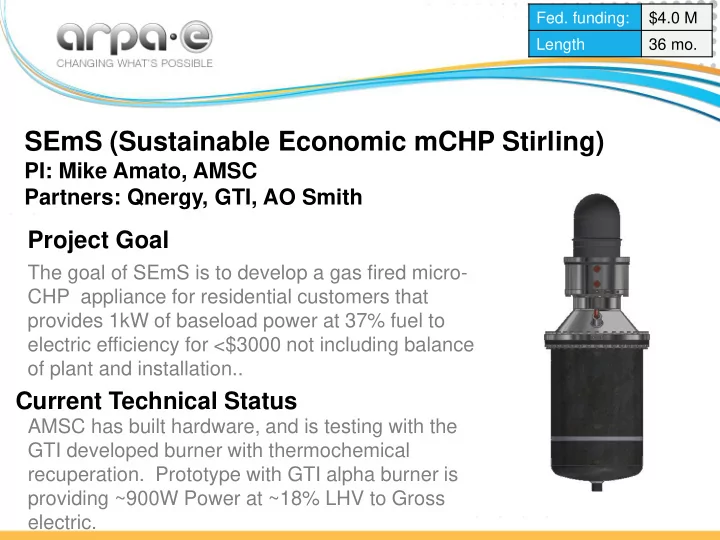

Fed. funding: $4.0 M Length 36 mo. SEmS (Sustainable Economic mCHP Stirling) PI: Mike Amato, AMSC Partners: Qnergy, GTI, AO Smith Project Goal The goal of SEmS is to develop a gas fired micro- CHP appliance for residential customers that provides 1kW of baseload power at 37% fuel to electric efficiency for <$3000 not including balance of plant and installation.. Current Technical Status AMSC has built hardware, and is testing with the GTI developed burner with thermochemical recuperation. Prototype with GTI alpha burner is providing ~900W Power at ~18% LHV to Gross electric.
Pitch Plan The AMSC GENSETS team will bring to market a 1kWe micro- cogeneration appliance, using a free piston Stirling engine (FPSE) to supply over 8.0MWh/yr. of electricity as well as satisfy the domestic hot water needs (60-70 gal/day) of a standard residence. Key features: • Low emissions • High efficiency >90% (total efficiency of 1.3kW thermal plus 1kWe) • Minimal maintenance • A useful life of at least ten years Additional appliance functionality options: • Space heating utilizing excess heat • Dehumidification • Backup power during grid outages
Pitch Plan System savings for a residence with the following assumptions: • 70 gal/day • 62% water heater efficiency • 140º F water temperature March 26, 2018
AMSC/Qnergy SEmS SEMS Technology • SEmS technology is similar to an existing 3.5 kWe Stirling convertor architecture that was used in prior solar applications • Qnergy’s Free -Piston Stirling Engines (FPSEs) are maintenance free throughout their lifecycle, which is proven on multiple engines with over a decade of Burner continuous operation. Internal components are hermetically sealed with Free-Piston Cooling Heat Out no internal corrosion or friction. Stirling • Heat rejection from engine to a hot water Flexure Generator Bearings tank may be done via two-phase water thermosiphon, reducing cost, power loss, and maintenance associated with a pump. Linear Alternator Electricity Out
SEmS Technology SEmS Prototype Status • First prototype is a bench-top demonstrator with pumped-loop cooling • Initial testing and tuning of engine performed with non- recuperative burner • Power output up to 900W • Efficiencies of up to 40% (55% Carnot) at 843W • Over the last quarter, the GTI designed burner with thermochemical recuperation has been integrated with the FPSE
Tech-to-Market Strategy Approach to market • At the end of Y2, SEmS is not meeting the performance, or cost requirements for a 1-2kW mCHP device. • Market research has verified that for developing markets, (first cost is king). Initial market penetration will be crucial to prove the technology to early adopters. The markets identified for initial entry are remote power users such as: • Oil and Gas • Telecommunications • Railroads • Military • Marine Auxiliary Power • Recreational vehicles • Transition to CHP after initial market penetration, and volumes start to bring down cost
Tech-to-Market Strategy Approach to market • As the SeMS project concludes - A manufacturing partner, such as A. O. Smith will finish CHP product development and will pull the product into the CHP market • AMSC will supply the SEmS engine design to the manufacturing partner and their partners for fabrication • The SEmS engine is designed to use mass manufacturing and assembly processes • Qnergy can provide manufacturing support to AMSC and the manufacturing partner, as the team develops a supply chain • Qnergy can assist AMSC in exploring other marketspaces as they already provide existing remote power generator offerings
Details on Envisioned Product Offering Metric Program Current Status Envisioned Target Product offering Device Application Residential Residential CHP Remote Power CHP Power (kWe) 1 0.9 1 Heat to electric eff 42 40 (Legacy Burner) 40 (Future Burner) Fuel-to electric eff 37 18 (GTI alpha Burner) >20 System cost ($) 3,000 14-16,000 At levels < 250 <12,000 ≤0.005 O&M cost ($/kWh) <0.02 <0.06 Capacity factor (%) 99.9 90% >95 ≥10 System Life (years) TBD >5 ≤55 System Noise (dB(A) 65 <70 at 3 feet away) ≤150 System Mass (kg) <250 TBD
Current Challenges Efficiency Challenge • The GTI alpha burner design is not coupling well with the SeMS engine, lowering the overall fuel to electric conversion efficiency • GTI is currently evaluating the alpha performance to understand changes for a beta burner and recuperator derivative Power Challenge • Currently, AMSC has identified that the engine has excessive piston biasing around its center location, preventing full amplitude operation • Porting modifications are being performed to reduce the piston amplitude bias to reasonable levels Cost / Market Challenge • First cost has been identified as the main driver in creating new markets • To compete, a technology has to be safe, efficient, and provide a reasonable payback period • CHP will probably not provide a breakout market for this technology, at its present performance and cost level • AMSC will pursue other market spaces for the SeMS system
Desirable Partnerships Desirable partnerships • A water heating manufacturer, such as AO Smith. • Gas and electric utilities. • Third party energy service providers.
Recommend
More recommend